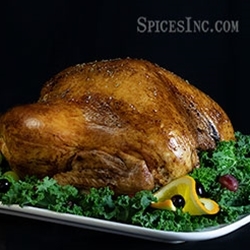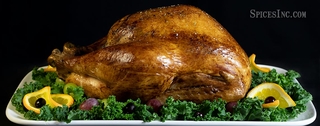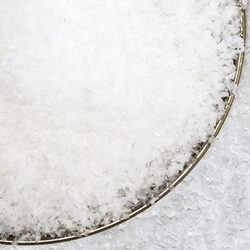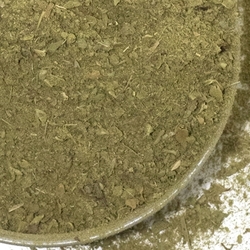Classic Roast Turkey

Is anything more emblematic (or intimidating) when it comes to holiday meal prep than a perfectly browned roast turkey? For new and experienced cooks alike, turkey creates a special dread. Will it be moist and flavorful? Will it be dry and dusty? Will the skin be crispy? Will it be soggy? It might seem like cooking a turkey that is both beautiful and edible is an impossible feat. Don't panic! We are here to guide you through it.
As far as what kind of turkey to choose, opt for what makes sense for your lifestyle. Buying a fresh turkey saves you from having to remember to take your turkey out of the freezer and move it into the fridge to thaw, but fresh turkeys are often in high demand and have to be ordered early. Frozen turkeys can be purchased whenever you like, but if you wait too long to buy one, you'll either have to settle on a monstrous bird that can feed 20, or buy two or three smaller breast-only turkeys. Remember to give your frozen bird a few days to thaw; you want it warm up gently, and not have to immerse it in water in the sink to take the freeze off.
We used a 12-pound turkey for our recipe which provides enough meat for about 8 people. If you have a larger crowd to feed, make sure you adjust your seasonings and cooking time accordingly. Pro tip: If you don’t already have a digital meat thermometer, now is the time to invest! You’re going to want to monitor the interior temperature of the turkey to know when the bird is done, rather than using a timer. Probe thermometers can stay in the turkey during cooking, and ring an alert once a pre-set cooking temperature has been reached. Instant read thermometers are inserted during cooking and will display an interior temperature at that moment. Both are excellent and reliable ways to check your turkey, so invest in whichever one seems the most practical for you.
One of the things that can contribute to a distorted interior temperature is a turkey that's got stuffing in its chest cavity. Yes, it's nostalgic, and we've all surely seen our mothers and grandmothers make turkey this way, but it's not a good idea. Stuffing that's had turkey drippings cook into it needs to reach the same internal temperature as the turkey, which is 165°F. Letting it cook to a lower temperature encourages the growth of salmonella, which often infects turkeys as they're processed for consumption and thrives in a warm, nutrient-rich environment, like stuffing. Cooking it to a serve-safe temperature of 165°F is the only way to guarantee you've killed the bacteria, and that's also a great way to overcook the meat. The flip side is, un-stuffed turkey cooks faster than stuffed turkey. Add some carrots, an onion, and some celery into the cavity to add aromatic flavor without extra density. You can clean the vegetables, but you don't have to bother peeling the carrots or cutting anything off the onion except the hairy roots at the end. Chop in large chunks and put them right in the cavity, and bake the stuffing in a separate dish.
We're going to interject for a moment here to talk about brining. Brining is an age-old method of seasoning and preservation, and it helps add flavor and moisture to meat that has a reputation for being dry and kind of bland. It does add a few extra steps to the cooking process, but the end result is so worthwhile you may never go back. At least 8 hours and up to 24 hours before you plan to cook, start the brine prep. We recommend a 1-pound bag of Turkey Brine Seasoning for a turkey that's as big as 14 pounds. Boil the brine in two gallons of water or a combination of water and vegetable or chicken stock. Boiling will "wake up" the seasonings in the brine mix and extract the flavors into the soaking liquid. Allow the liquid to cool completely, then put the turkey and the brining liquid into a brining bag. Put the turkey in the refrigerator or in a cooler filled with ice, and let the brine penetrate the meat and infuse it with moisture and flavor. We've found that a 12-hour brine is optimum. When you're ready to cook, pull the turkey from the brine, rinse it with cool water, and pat it dry with paper towels. Discard the brine. Then prepare your turkey as you normally would for roasting.
On the day you're cooking your turkey, take the bird out of your refrigerator (or brine) an hour before you plan to cook, to let it come up to room temperature. After the turkey has started to warm up, set your initial oven temperature to 500°F. This may seem high, but you're only going to maintain that temperature for the first half hour to get that photoshoot-worthy, brown and crispy turkey skin. As your oven is preheating, liberally massage the turkey with lots of butter that’s been mixed with Poultry Seasoning. This seasoning blend has thyme, rosemary, sage, marjoram, and oregano, and it adds an herbal lift to any poultry, soups, roasted potatoes, and goes wonderfully with the stuffing you've mixed and are ready to pour into a separate baking pan. This seasoning is salt-free, so adjust salt and pepper to your tastes accordingly.
After you’ve blitzed your turkey in 500°F for a half hour and it’s been gorgeously tanned, you can adjust your oven temperature down to 350°F for the remainder of the cooking time; a standard calculation to use is 13 minutes per pound when roasting at 350°F, but this is where a reliable thermometer comes in handy. While you can "guess" you're close enough to doneness but looking for clear juices and loose movement in the turkey joints, with a kitchen thermometer, you'll know. Insert your thermometer into the thickest part of the turkey, being careful not to rest it on a bone, which can give a false reading. When your thermometer reads 161°F, pull the turkey out of the oven and cover it with foil. Let it rest for at least 30 minutes so that the residual heat continues to cook the turkey to the serve-safe temperature of 165°F. This also gives the turkey's juices, which are pulled to the top layer of the bird while cooking, the opportunity to settle back into the meat, making for a juicier bird at the finish.
If you are cooking for just one or two, you might choose to make Cornish Game Hens instead. Invite your vegetarian friends for dinner, too, and try a Butternut Squash and Sage Lasagna recipe. Then everyone can come together and feast, and isn't that what the holidays are all about?
- 12-pound fresh or frozen turkey
- 4 Tablespoons unsalted butter, slightly softened
- 1 Tablespoon Poultry Seasoning
- 1 teaspoon Kosher Salt
- 1 teaspoon Black Pepper Medium Grind
- 1 stalk celery, roughly chopped
- 1 carrot, roughly chopped
- 1 onion, quartered
- If brining
- 1 pound Turkey Brine Seasoning
- 2 gallons water or a combination of water and vegetable or chicken stock
- Remove fresh or thawed turkey from refrigerator. Preheat oven to 500°F.
- Remove neck and giblets from turkey and dispose or set aside for later use.
- Place the onion, carrot, and celery in the cavity. Do not overstuff, as this will make the cooking time longer.
- Mix Poultry Seasoning with butter. Massage the butter all over the outside of the turkey. Season with Kosher Salt and Black Pepper.
- Place turkey in roasting pan, and roast uncovered for 30 minutes at 500°F.
- Remove turkey from oven, and reduce temperature to 350°F. Cover only the breast portion of the turkey with foil. If you're using a digital probe thermometer, insert it into the deepest part of the breast and place the temperature readout on your counter. If you're using an instant-read thermometer, check on turkey temperature periodically but do not leave the thermometer in during cooking time.
- Place turkey back in 350°F oven and roast until the thermometer reads 161°F. The temperature will raise a few degrees even after its out of the oven, going past the target temperature of 165°F. This should take approximately 2 1/2 to 3 hours. The cooking time will vary depending on the size of the turkey you are roasting.
- Once meat thermometer reads 161°F, remove from oven and let rest for 30 minutes before carving.
Recipe notes:
- This recipe is based on roasting a 12-pound turkey. Cooking times will vary depending on the size of your bird.
- If you're brining, immerse it in brine the day before you plan to cook. Use 1 pound of brine to 2 gallons of water, for a medium turkey (up to 14 pounds). Keep the turkey in a cool place--the refrigerator, or in a cooler, surrounded by ice--as it brines, to impede any bacterial growth. When turkey is finished brining, throw the brine out. Rinse, pat dry, and cook as usual.
- If you are roasting a turkey that's larger than 12 pounds, increase the amount of carrot, onion, and celery. Use 2 carrots, 2 onions, and 2 stalks of celery in an 18-pound bird. Do not overstuff, as this will increase cooking time, and could dry out your turkey. This goes the same for the amount of butter and Poultry Seasoning as well.
- We do not recommend filling your turkey with any kind of stuffing as it both increases the cooking time and could put you at risk of salmonella poisoning. Instead, bake your stuffing separately in a pan.





